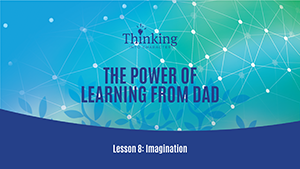Lesson 8: Imagination
Lesson 8 – Imagination – Part 1
The imagination has been called “the workshop of the mind” and this is in part because, the imagination is the mental “space” in which new ideas are created. Through the imagination you can devise new ideas and strategies that will help you to achieve your desired outcomes.
There are two types of imagination: synthetic imagination and creative imagination. Creative imagination is the activity of thinking entirely new ideas. Synthetic imagination is the activity of combining old ideas in new ways to create a new combination of ideas. Both faculties of imagination are important to success creation. When these imaginative faculties are made alert and receptive to desires they begin at once to work to think up ideas for the satisfaction of those desires. What this means that each of us essentially has a creative problem solving mechanism at our disposal.
There are two types of imagination: synthetic imagination and creative imagination. Creative imagination is the activity of thinking entirely new ideas. Synthetic imagination is the activity of combining old ideas in new ways to create a new combination of ideas. Both faculties of imagination are important to success creation. When these imaginative faculties are made alert and receptive to desires they begin at once to work to think up ideas for the satisfaction of those desires. What this means that each of us essentially has a creative problem solving mechanism at our disposal.
“The great leaders of business, industry, finance and the great artist, musicians, poets, and writers became great, because they developed the faculty of the creative imagination”
Everyone is naturally endowed with and can make use of both the creative and the synthetic imagination. That means everyone can be creative or imaginative. While it is true that the imaginative faculties can easily become dormant through lack of use it can just as easily be revived and made alert through use. The capacity of imagination is developed and strengthens through use. The more you use your imagination, the stronger it gets.
A final point to note: while we cannot underestimate the importance of the imagination – every new product or service starts off as an idea in the imagination of its producer – imagination must be coupled with action to create success. In other words, success involves the effective use of the imagination backed by action. Creating a picture in your mind alone will not get you the success you seek. Imagination is therefore creative tool that takes you to the door of action.
For more on taking effective action see Lesson 4 on Action.
Lesson 8 – Imagination – Part 2
In part 2 of our video on the imagination, we will look in closer detail at the remarkable properties of the imagination, beginning with ideas. Unlike a table or a chair, ideas are intangible forces. As intangible forces, ideas can be incredibly powerful. Some ideas, like those associated with popular social and political movements, are so powerful in fact, that they outweigh the brains that gave birth to them.
When you bring an idea to life, through action, what has literally happened is that a picture that you had in your mind has come into reality as a result of your imaginative activity. This notion of bringing something tangible from the intangible is one that has fascinated theologians for centuries as it is speculated that the same mechanism was used by God to have created the tangible universe from intangible spirit. While the object of this lesson is not to discuss theology, it is worth drawing to your attention the idea of this quasi-divine capacity that you have to create the tangible from the intangible, through the actions you take to bring ideas to life.
Genevieve wrote:
“Everything in the whole world, from the hat on your head to the boots on your feet, has its beginning in mind and comes into existence in exactly the same manner. All are projected thoughts, solidified.”
Exploring Genevieve’s idea here brings with it some useful insights, which are discussed throughout the video. One key insight is this: it is absolutely essential that as you use the faculty of imagination, especially of creative imagination, to produce ideas that will help you to advance towards your goals, it is important that you form a clear mental picture of the idea, with as much detail as is possible. Why is that? If it is the thoughts that you have that are being solidified through the process of action, holding a very clear picture in mind will assist you to get the results that you desire, quicker. An unclear image will lead to haphazard results.
As an analogy, if you want to build a house but do not have a detailed plan, the building will not end up in a good shape. Similarly, having a clear idea of exactly what you want, and having a mental picture of it, is critical to taking the most effective actions to bring about that result. To begin to use the powerhouse of imagination to achieve results therefore requires you to have a clear mental picture of what you wish to achieve.
Of course, we must remember that in this process of creating clear mental pictures either of a desired result or of a potential new product or service, we must continue to understand and place value on the importance of action. Your imagination will give you answers, but it must be linked with actions for results to emerge.
In summary: imagination creates a picture, we take action every day, and this is the process of making the intangible tangible. By building our ideas and transforming them into reality through a series of actions, we arrive at the successful realization of our desired goals. In this activity, remember to be patient, don’t let the distractions of daily life put you off course. Continue with the actions required to bring imagination to life.

